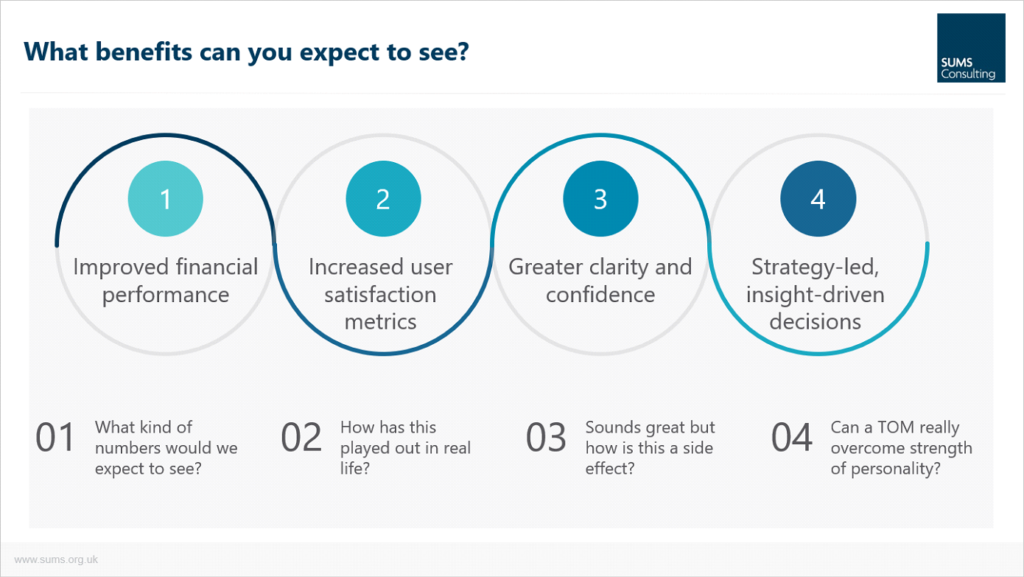
| Date | Author |
|---|---|
| 20th January 2021 | David Becker |
Against a backdrop of continuous change in the higher education landscape, our lead for organisational design and efficiencies, David Becker, sat down with Marion Hutchins, SUMS Head of Marketing and Communications, to discuss the merits of universities developing Target Operating Models.
Q: Can you kick us off today by explaining what Target Operating Models actually are and why you think an effective one is essential for universities?
A: Definitely – and it’s a pertinent question because some of the language around Target Operating Models (TOMs) is unnecessarily heavy on jargon which goes down like a lead balloon in university circles!
Essentially, a TOM is a description of an organisation’s ideal state. I like to visualise it as the destination at the end of the bridge an organisation needs to cross to get from its current location (the ‘as is’) to its desired new one (the ‘to be’). In the same way that a physical bridge is supported by engineering infrastructure that makes it safe and roadworthy, in the world of Target Operating Models, the bridge’s stability is made up of your university’s people, their capabilities, the business processes and IT systems, and structures that hold the university together.
The key to high performance, however you choose to define it, lies in coordinating all of those things effectively. If you can improve the way you do that then you can cross the bridge much more quickly and accelerate delivery of your strategy. And if you can do it more effectively than other universities then you stand a good chance of gaining competitive advantage too.
Q: How does a TOM differ from the change programmes we’ve seen universities implement in the past and why is this important?
A: Firstly, although there’s a lot of literature about the numbers of change projects that fail, it’s worth taking a moment to reflect on the speed and dexterity with which so many institutions have adapted to the shifting sands caused by Covid-19. Although most university staff could share a horror story about a change project which went badly, it isn’t true that they all fail to deliver any benefits.
Of course, you don’t always have to look too hard to find examples of business change ambitions which are a little one-dimensional. We’ve all seen, at times, an unhelpful fixation on organisational structures or peripheral changes to the boundaries, make-up or names of individual faculties or departments.
On the flip side, there are universities which have poured considerable effort and resources into process improvement initiatives but have then found themselves unable to cash in the benefits of the work or embed those skills across the institution. Sometimes that’s because of insufficient IT development time, sometimes it’s because the university doesn’t have access to sophisticated organisation design skills. Quite frequently it’s because data maturity is at a really low level and the institution is trying to run before it can walk. There are a ton of other reasons too.
Developing a Target Operating Model isn’t a solution to all ills by any stretch of the imagination. However, it is a more sophisticated framework than any project which looks solely at processes or structures or which focuses on a small number of departments in isolation. A good TOM process will break the whole system down into all the components that show you how the university works; not just the structure charts and key business processes, but the supporting IT systems, the third-party suppliers, the dependencies with other service areas, relative increase in spend on certain activities over time and so on.
It also focuses heavily on user journeys and that helps you plan operations that deliver what stakeholders need rather than what you think they should get. With that kind of rich picture, you can start to explore more cleverly and with greater confidence where things are holding you back. In turn, that makes it easier to plot the route which takes you over the bridge to a new operating model – your Target Operating Model.
Q: I know you are a big advocate for the power of data and business intelligence in TOM design. What can the data tell us?
A: Yes, the combination of qualitative and quantitative insight is very powerful, not least because every stakeholder has their own preferences for how they receive and process insight. That insight is always dependent on the context, though.
If I take a typical scenario, we might have a university which is under pressure to reduce its operating cost and demonstrate more bang for its buck in terms of the investment it has made in its various forms of provision. There’s so much data that can help us get a feel for where the problem and opportunity areas might be. We can look at:
- The data available through the HESA statutory reporting process
- Internal data held across the university e.g. data held in the student record system, finance system, or HR systems
- Bespoke and granular insight from relevant comparators in the SUMS Group member base
- Any other benchmarking the university might have done either themselves or through other consultancies.
Ultimately, any combination of these things lets you start to examine your university’s performance in a way that goes beyond the narrative you might typically hear from university staff.
I’d be here all day if I took you through an exhaustive list of what to look for, but as a starter for ten, you could examine the distribution of your spend by staff category over time. For example, one university we’ve worked with in the last year had recorded very high increases in the percentage of its overall spend on staff in administrative and secretarial occupations over a five-year period. At the same time, it had recorded a disproportionately large decrease in staff in professional occupations. Given the potential for increasingly digitised business processes and given the advancement in developments around AI, robotic process automation and machine learning, we’d expect manual and administrative investment to be steadily reducing. So just one component there out of hundreds which immediately gives you one important line of inquiry.
When it comes to student data, there are a number of things that I would suggest are initially reviewed too. That includes the level of study, which can help you to pinpoint risks around the mix and distribution of students. You should also look at subject, through the cost centre data, which will help to identify areas of growth and contraction that can support the strategic direction of your institution. Finally, you should examine the demographic profile of your students, which can help with pinpointing resource in areas such as equality and diversity. Again, you can overlay all of these areas with existing intel from the likes of the NSS survey or point-of-service satisfaction metrics as well as exploring your staff, student, and finance data alongside each other to really leverage the data asset. It all helps provide an evidence base and platform for making the right kind of change.
I can’t emphasise enough the importance of building change on a robust and evidence-based platform. I’m not pretending that people won’t still contest it, because they will – challenge and debate is woven into the very fabric of the sector – but it’s a far better starting position than choosing to do something because of individual preference or because university X did something similar and it worked for them.
Q: What benefits have universities seen through developing a TOM?
A: One of the reasons I’m an advocate for Target Operating Models is that they deliver real results if they’re implemented fully. One institution which used a TOM framework to address the first-year student experience saw student satisfaction levels jump from 85% up to 93%. When we ran the diagnostic stage of our TOM design for a small university earlier this year, it highlighted the potential to make savings of up to £5m without any notable impact on strategy delivery.
If we move away from cost and satisfaction metrics, the TOM process has also helped universities prioritise more effectively. One Vice-Chancellor commented on the sheer breadth of activity his university was involved in by saying that they were ‘great midwives but terrible undertakers’. By using the TOM process to refocus on the relative strategic impact of its many investments, parameters could be developed to help you decide which activity could be reduced or stood down. These parameters can then be used to determine future priorities and stop the problem of activities constantly starting but then never being stopped, irrespective of their performance or contribution.
One of the things I’m really keen on is making sure that Target Operating Models don’t just fix the problems universities have today – they ensure universities are fit for the future. The tensions in the future higher education landscape are becoming clearer by the week. Universities need to be asking themselves bigger questions about how they intend to adapt to the world in front of us.
Do they want to be a leader or a follower when it comes to AI, machine-learning, robotic process automation? Should they be pushing to abandon the academic year and encourage self-paced, deeply personalised learning journeys? Are there opportunities to form regional alliances with other institutions to create economies of scale? What do changing generational expectations of a university experience mean for the way they organise themselves? These are big questions, but a good TOM can support future operations and not just make current operations more efficient.

Alt text: An image that shows why Target Operating Models can greatly improve the university experience
Q: What can go wrong with TOM design? Are there any misconceptions about it that you think need correcting?
A: Let me start with misconceptions because we do observe plenty of those. There are six that I’d particularly highlight:
⦁ There is definitely still a misunderstanding in some quarters about what a TOM actually is. The TOM is often conflated with the organisational structure in particular, whereas that’s just one component of it.
⦁ The TOM is sometimes confused with the strategy itself. For example, people may wonder why TOM blueprints aren’t setting out a fundamental change to the markets from which a university recruits, or why they aren’t recommending the extent to which it should pivot to different modes of delivery. The overall point is that the TOM is an enabler of your strategic ambitions; it doesn’t determine those ambitions itself. The example I use is that of my football club, Preston North End. If we had a vision to win the Champions League in two years’ time supported by a strategy of investing £100m to make that happen, there is still no operating model in the world that could achieve it. In short, no TOM can fix strategic absurdities or leadership deficits.
⦁ There can be too big a focus on resolving problems with the ‘as is’ without giving due attention to how the world is changing, how that will impact operational delivery in the coming years and how a university can future-proof its operating model rather than just make it fit-for-purpose for the world as it stands today.
⦁ A related issue is that a TOM could set out a mode of operation that’s simply not possible to achieve until the basics are resolved. For example, no university will be able to fully exploit the potential of AI until its data is a genuine asset; well-managed, joined-up and fit-for-purpose.
⦁ Another misnomer is that the TOM is something you develop, work towards, achieve and then the work is done. Actually, a TOM is an ongoing process. The same reasons which trigger universities to create one in the first place are also the reason why the TOM has to keep evolving. TOM development and implementation is a race a university needs to be in if it wants to be a high performer but it’s a race that never ends.
⦁ A TOM needs a partner in the form of a transition plan. In and of itself the TOM is just a description of the world as you wish it to be. If you want to get the full benefit from it then you need to commit to a substantial volume of ‘on the ground’ delivery with all the risks and issues that go alongside any large transformation programme. The design is the easy bit!
What support can universities access from SUMS if they’re keen to explore a Target Operating Model?
Universities are all at different stages of their TOM journey, but our pool of expert consultants can help verify the maturity of your plans, conduct external benchmarking to provide richer insight and a firmer evidence-base, or make implementation more impactful through effective programme governance, change controls and objective facilitation.
Universities who choose SUMS as their partner can access the support of our business intelligence and analytics consultants, organisation design experts (who’ve been there, done it and got the t-shirt) and subject matter experts across every professional service domain including HR, Finance, Marketing and Estates. And, as always, you can be pretty much guaranteed that the price you pay will be more competitive than other consultancies because we’re a not-for-profit that reinvests any surplus we make back into our sector. Universities with an existing SUMS membership can also commission work without the administrative burden of tender which helps reduce bureaucracy and inject pace and agility into our programmes of support.
For more information on how SUMS Consulting can support your university with developing your Target Operating Models, effective change management or other areas of performance improvement, contact David at d.becker@reading.ac.uk.








